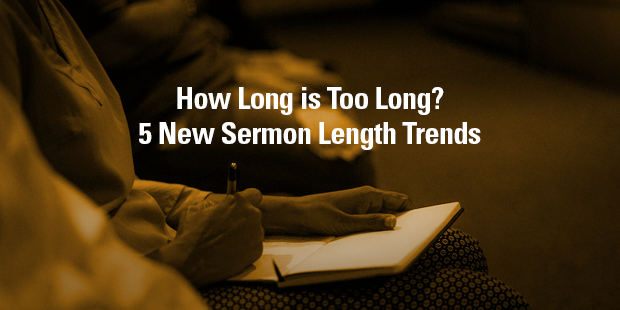
How Long is Too Long? 5 New Sermon Length Trends
One thing is for certain regarding the proclamation of God’s Word: preaching is still primary for both pastors and church members.
Because of the centrality of preaching in most churches, it is always fascinating to learn what developments are taking place in the preaching ministry. I recently conducted another social media survey on sermon length. This time, however, I asked an additional question. The two questions were as follows: What is your typical sermon length? Has it changed over your ministry?
We received nearly 1,000 responses. With that volume of great feedback, we were able to see five clear trends:
- Pastors are, for the most part, changing sermon length over the course of their ministry (Trending Up
). Over eight of ten pastors indicated they had made significant changes to their sermon length in their ministries. There were a number of reasons for the changes, but the most common was adapting to listening patterns of the congregation.
- Sermon length is down slightly over the past four years (Trending Down
). The median length of the sermon of those surveyed was 27 minutes, down from 29 minutes four years ago.
- Though a number of respondents indicated changes to sermon length were longer than previous years, by a 3:2 margin more pastors were moving to shorter sermons (Trending Down
). Since this point is similar to number two above, you would expect more pastors moving to shorter sermons than to longer sermons.
- Many of the pastors who were resistant to shortening the length of their sermons were compelled to do so when they went to multiple services, multiple sites, and/or multiple venues (Trending Down
). This pastor said it well: “I preached around 50 minutes until we added a second service. I had to trim the length by 10 minutes just for logistical reasons. It about killed me!”
- The number of pastors whose sermon length is an outlier (fewer than 15 minutes or greater than 50 minutes) is small but stable (Trending Stable
). Fewer than five percent of the pastors who responded preach sermons whose length is an outlier because of its brevity or longer length. The number of outliers has not changed significantly, but the advocates of either extreme tend to be clear and eager to verbalize the benefits of their sermon lengths.
Thank you, first, to the Church Answers’ community for starting this discussion. And thank you to the hundreds of you who responded.
What is your typical sermon length? Has it changed over the course of your ministry?

Tags: Communication, Sermon Length, Thom Rainer













